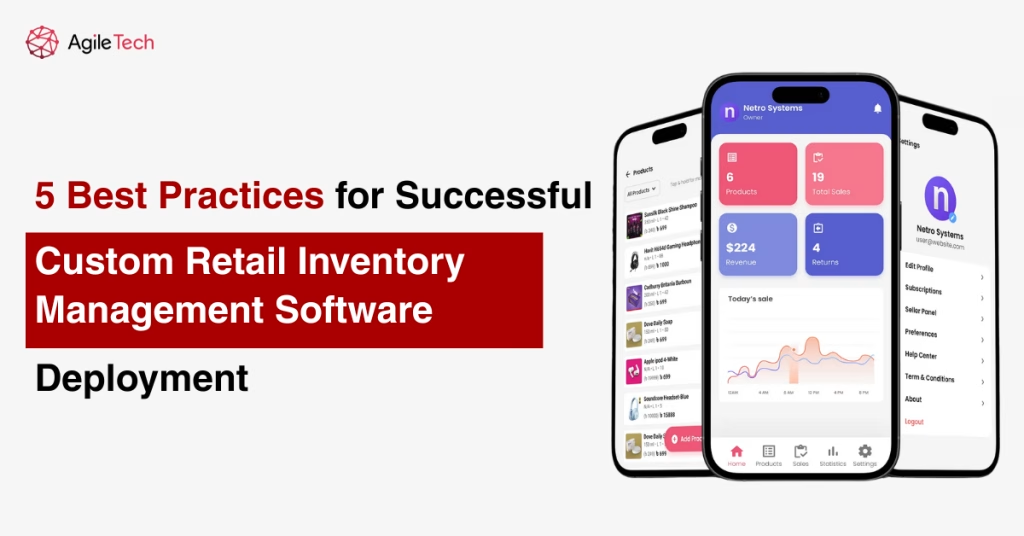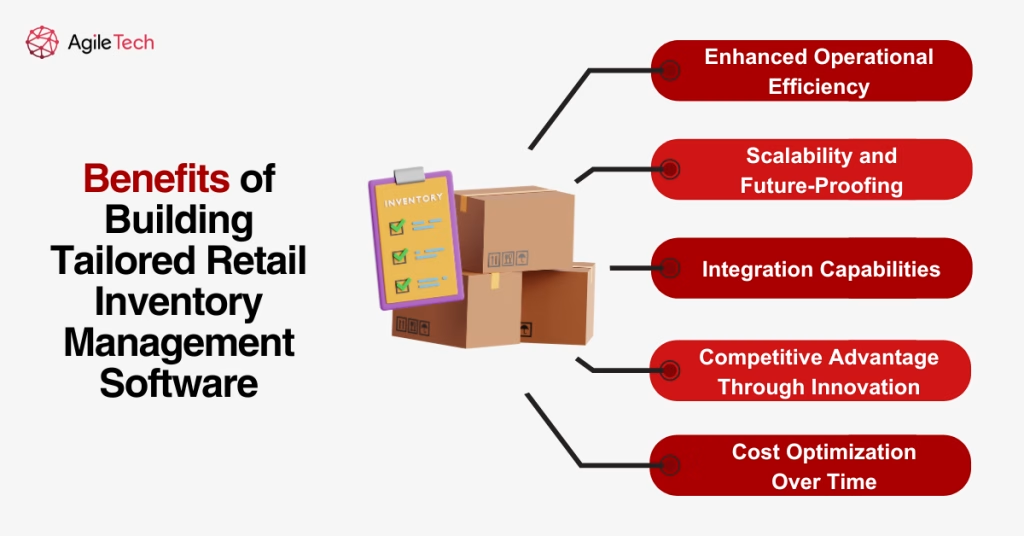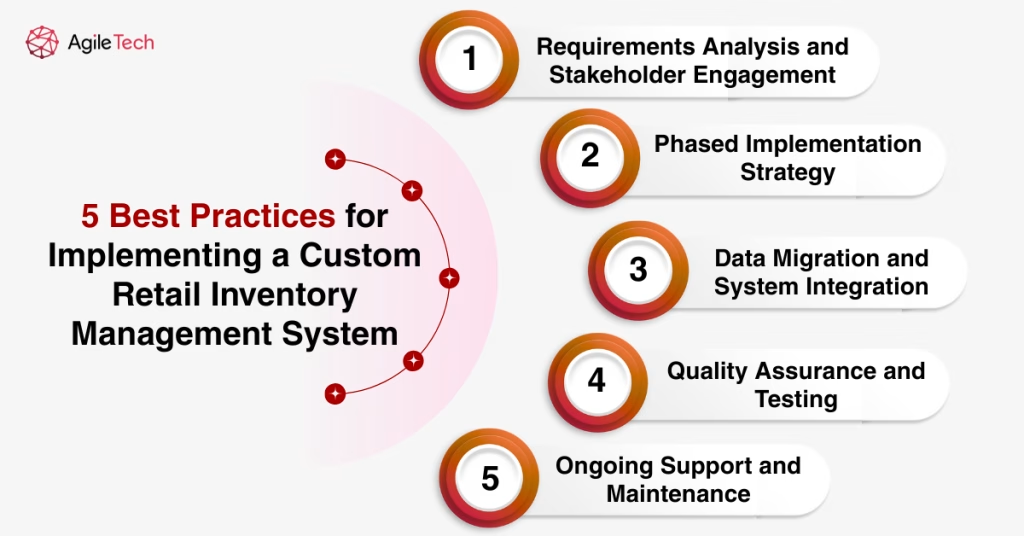5 Best Practices for Successful Custom Retail Inventory Management Software Deployment
Modern retail businesses require sophisticated inventory management solutions that go beyond one-size-fits-all approaches. Custom retail inventory management software offers tailored functionality, seamless integration capabilities, and scalable architecture designed specifically for unique business requirements and operational workflows.

- 1. Why Custom Retail Inventory Systems Are Essential for Modern Businesses
- 2. Benefits of Building Tailored Retail Inventory Management Software
- 3. Core Technical Architecture for Retail Inventory Management Software
- 4. 5 Best Practices for Implementing a Custom Retail Inventory Management System
- 5. AgileTech – Trusted Custom Retail Inventory Management Software Vendor
- FAQs
1. Why Custom Retail Inventory Systems Are Essential for Modern Businesses
The retail landscape has evolved dramatically in recent years, with businesses operating across multiple channels, managing diverse product catalogs, and serving increasingly sophisticated customer expectations. Traditional retail inventory management solutions often fall short of addressing the complex requirements that modern retailers face daily.
The Limitations of Generic Solutions
Off-the-shelf inventory management systems typically provide standardized features that may not align with specific business processes. These generic solutions often create operational bottlenecks, forcing businesses to adapt their workflows to match software limitations rather than optimizing processes for maximum efficiency. Understanding what inventory management software is and its core capabilities helps businesses recognize when standard solutions fall short of their operational requirements. The retail inventory system becomes a constraint rather than an enabler of business growth.
Many retailers discover that generic solutions lack the flexibility needed to handle unique product variations, complex pricing structures, or industry-specific requirements. For instance, a fashion retailer managing seasonal collections with multiple sizes and color variations requires different functionality than an electronics retailer dealing with serial numbers and warranty tracking.
The Complexity of Modern Retail Operations
Contemporary retail operations involve intricate supply chain relationships, multi-location inventory distribution, and omnichannel customer experiences. Retailers must manage inventory across physical stores, warehouses, and online platforms while maintaining real-time visibility into stock levels, demand patterns, and supply chain disruptions.
Inventory management retail industry professionals recognize that successful operations require seamless integration between point-of-sale systems, e-commerce platforms, warehouse management systems, and financial reporting tools. This level of integration rarely exists in generic solutions, creating data silos and operational inefficiencies that impact customer satisfaction and profitability. Businesses must understand how inventory management software works to appreciate the integration complexities involved in modern retail operations.
Meeting Customer Expectations in a Digital Age
Modern consumers expect accurate inventory information, rapid order fulfillment, and consistent experiences across all touchpoints. Meeting these expectations requires sophisticated retail inventory control mechanisms that can process real-time data, predict demand patterns, and automatically trigger replenishment actions.
Custom retail inventory management solutions enable businesses to implement advanced features such as predictive analytics, automated reorder points, and intelligent demand forecasting. These capabilities transform inventory management from a reactive process into a proactive strategic advantage that drives revenue growth and customer loyalty.
2. Benefits of Building Tailored Retail Inventory Management Software
Investing in custom software development for inventory management in retail provides numerous advantages that extend far beyond basic stock tracking functionality. These benefits create substantial value for businesses seeking to optimize their operations and gain competitive advantages in their respective markets.

2.1. Enhanced Operational Efficiency
Custom retail inventory management software eliminates the inefficiencies associated with workarounds and manual processes required by generic solutions. Businesses can design workflows that align perfectly with their operational procedures, reducing the time and effort required for routine tasks such as receiving, counting, and transferring inventory.
The software can incorporate industry-specific features that generic solutions typically overlook. Custom solutions can include specialized inventory management software features that address unique business requirements without compromising functionality. For example, a grocery retailer might require batch tracking and expiration date management, while a jewelry retailer needs detailed tracking of precious metals and gemstones. These specialized requirements are seamlessly integrated into custom solutions without compromising functionality or user experience.
2.2. Scalability and Future-Proofing
Retail store inventory management requirements evolve as businesses grow and expand into new markets or product categories. Custom software solutions provide the architectural flexibility needed to accommodate growth without requiring complete system replacements or costly migrations to new platforms.
The modular design approach commonly used in custom development allows businesses to add new features and capabilities incrementally. This approach ensures that the inventory management system continues to meet evolving business needs while protecting the initial investment in software development.
2.3. Integration Capabilities
Modern retail operations depend on seamless data flow between multiple systems and platforms. Custom retail inventory management software can be designed with specific integration requirements in mind, ensuring smooth communication with existing enterprise resource planning systems, customer relationship management platforms, and third-party logistics providers.
These integration capabilities eliminate the need for manual data entry and reduce the risk of errors that occur when information must be transferred between disparate systems. Real-time synchronization ensures that all stakeholders have access to accurate and up-to-date inventory information.
2.4. Competitive Advantage Through Innovation
Custom software development enables businesses to implement innovative features that differentiate their operations from competitors. These might include advanced analytics capabilities, artificial intelligence-powered demand forecasting, or unique customer experience features that enhance brand loyalty and market position.
The ability to rapidly implement new features and respond to market changes provides significant advantages in dynamic retail environments. Custom solutions can be updated and enhanced continuously, ensuring that businesses maintain their competitive edge as market conditions evolve.
2.5. Cost Optimization Over Time
While custom software development requires significant initial investment, the long-term cost benefits often justify the expense. Understanding inventory management software cost factors helps businesses evaluate the long-term financial benefits of custom development versus ongoing licensing fees. Businesses avoid ongoing licensing fees associated with commercial software, reduce operational costs through improved efficiency, and eliminate the need for costly customizations or third-party integrations.
Custom retail stock management systems also provide better return on investment through improved inventory turnover, reduced stockouts, and optimized purchasing decisions. These operational improvements typically generate substantial cost savings that offset the initial development investment within a reasonable timeframe.
3. Core Technical Architecture for Retail Inventory Management Software
The technical foundation of custom retail inventory management software determines its performance, scalability, and maintainability. Understanding the architectural components and technology choices involved in building these systems helps businesses make informed decisions about their software development investments. This technical foundation directly impacts how to create an inventory management software solution that meets performance and scalability requirements.
Core Technology Stack Components
Modern retail inventory management systems typically employ a multi-layered architecture that separates concerns and provides flexibility for future enhancements. The presentation layer handles user interfaces and client interactions, while the business logic layer processes inventory rules and workflows. The data access layer manages database operations and ensures data integrity across all transactions.
Cloud-based architectures have become increasingly popular for retail inventory management applications due to their scalability, reliability, and cost-effectiveness.
The choice of programming languages and frameworks significantly impacts the system’s performance and development efficiency. These technology decisions are fundamental to inventory management software development and determine the system’s long-term maintainability.
Popular backend technologies include Node.js for high-performance applications, Python for data analytics capabilities, and Java for enterprise-grade scalability. Frontend frameworks such as React, Angular, or Vue.js provide responsive user interfaces that work effectively across desktop and mobile devices.
Database Design and Management
Effective database design forms the foundation of reliable inventory management systems. Relational databases such as PostgreSQL or MySQL provide strong consistency guarantees and robust transaction support essential for accurate inventory tracking. The database schema must accommodate complex relationships between products, locations, suppliers, and transactions while maintaining optimal query performance.
For businesses with high transaction volumes or complex analytical requirements, hybrid database approaches combining relational and NoSQL technologies often provide optimal performance. Document databases like MongoDB can handle product catalog data with varying attributes, while time-series databases such as InfluxDB excel at storing historical inventory movements and analytics data.
Data backup and recovery strategies are critical components of the technical architecture. Automated backup procedures, point-in-time recovery capabilities, and disaster recovery planning ensure business continuity and protect against data loss. Regular testing of backup and recovery procedures validates the effectiveness of these protective measures.
API Design and Integration Architecture
Modern retail inventory management systems must integrate with numerous external systems and platforms. RESTful APIs provide standardized interfaces for data exchange, while GraphQL APIs offer more flexible query capabilities for complex data relationships. The API design should prioritize security, performance, and ease of integration for both internal and external developers.
Microservices architecture patterns enable better scalability and maintainability by decomposing the application into smaller, independent services. Each service handles specific business functions such as inventory tracking, order processing, or reporting. This approach allows teams to develop, deploy, and scale individual components independently.
Event-driven architecture patterns facilitate real-time synchronization between different parts of the system and external integrations. Message queues and event streaming platforms such as Apache Kafka or RabbitMQ ensure reliable communication between services while maintaining system resilience and fault tolerance.
4. 5 Best Practices for Implementing a Custom Retail Inventory Management System
Successful implementation of custom retail inventory management software requires careful planning, stakeholder engagement, and adherence to proven methodologies. These best practices help ensure that the development and deployment process delivers maximum value while minimizing risks and operational disruptions.

4.1. Requirements Analysis and Stakeholder Engagement
Comprehensive requirements analysis forms the foundation of successful custom software development. This process involves a detailed examination of current inventory management processes, the identification of pain points and inefficiencies, and the definition of desired future state capabilities. Engaging stakeholders from all relevant departments ensures that the solution addresses the needs of end users, managers, and executives.
The requirements analysis should include detailed workflow mapping that documents how inventory moves through the organization from initial purchase through final sale. This mapping identifies integration points with existing systems, data flow requirements, and critical business rules that must be implemented in the custom solution.
User story development and acceptance criteria definition provide clear guidance for the development team, ensuring that business requirements are accurately translated into technical specifications. Regular review and validation of requirements with stakeholders helps maintain alignment and prevent scope creep during the development process.
4.2. Phased Implementation Strategy
Large-scale inventory management system implementations benefit from phased deployment approaches that minimize risk and allow for iterative improvements. The initial phase typically focuses on core functionality such as basic inventory tracking, receiving, and reporting capabilities. Subsequent phases add advanced features such as demand forecasting, automated reordering, and advanced analytics.
Pilot deployments in selected locations or product categories provide valuable feedback and allow for refinement before full-scale rollout. This approach enables businesses to validate the solution’s effectiveness and make necessary adjustments without impacting entire operations.
Change management strategies ensure that employees are prepared for the transition to new systems and processes. Training programs, documentation, and ongoing support help users adapt to new workflows and maximize the benefits of the custom solution.
4.3. Data Migration and System Integration
Data migration from legacy systems requires careful planning and execution to ensure accuracy and completeness. Data cleansing and validation procedures identify and correct inconsistencies or errors in historical data before migration. Comprehensive testing of migrated data validates accuracy and completeness across all business functions.
Integration with existing systems must be thoroughly tested to ensure seamless data flow and process continuity. API testing, error handling validation, and performance testing under realistic load conditions help identify potential issues before they impact operations.
Rollback procedures and contingency plans provide safeguards in case unexpected issues arise during implementation. These plans ensure that business operations can continue even if technical problems occur during the transition period.
4.4. Quality Assurance and Testing
Comprehensive testing strategies validate both functional and non-functional requirements of the custom inventory management system. Unit testing ensures that individual components function correctly, while integration testing validates the interaction between different system modules and external integrations.
User acceptance testing involves end users in validating that the system meets their operational requirements and workflow expectations. This testing phase often reveals usability issues or missing features that may not be apparent during technical testing.
Performance testing under realistic load conditions ensures that the system can handle expected transaction volumes without performance degradation. Security testing validates that appropriate access controls and data protection measures are functioning correctly.
4.5. Ongoing Support and Maintenance
Post-implementation support ensures that the custom inventory management system continues to meet business needs and operates reliably. Regular system monitoring identifies potential issues before they impact operations, while proactive maintenance prevents problems from occurring.
User feedback collection and analysis inform ongoing system improvements and feature enhancements. Regular review of system performance metrics and user satisfaction surveys helps identify areas for optimization and enhancement.
Software updates and security patches must be applied regularly to maintain system security and functionality. Automated update procedures minimize disruption while ensuring that the system remains current with the latest security standards and feature improvements.
5. AgileTech – Trusted Custom Retail Inventory Management Software Vendor
AgileTech is a leading software outsourcing partner specializing in custom retail inventory management solutions. With deep industry experience and a strong track record, we help retailers streamline operations, improve accuracy, and scale efficiently.
Comprehensive Development Expertise
Our team combines retail domain knowledge with advanced technical skills to build tailored systems for multi-location inventory, demand forecasting, automated reordering, and analytics. We collaborate closely with clients to align every solution with their workflows, ensuring both usability and long-term value.
Proven Implementation Methodology
AgileTech follows an agile, transparent development process, from initial discovery to iterative sprints and quality assurance. This approach allows for early validation, fast feedback loops, and successful, on-time delivery with minimal risk.
Ongoing Support and Partnership
Post-deployment, we offer reliable maintenance, regular updates, and proactive monitoring. Our support team ensures performance stays high and disruptions are minimal. We also provide strategic consulting to help clients stay ahead of evolving retail trends.